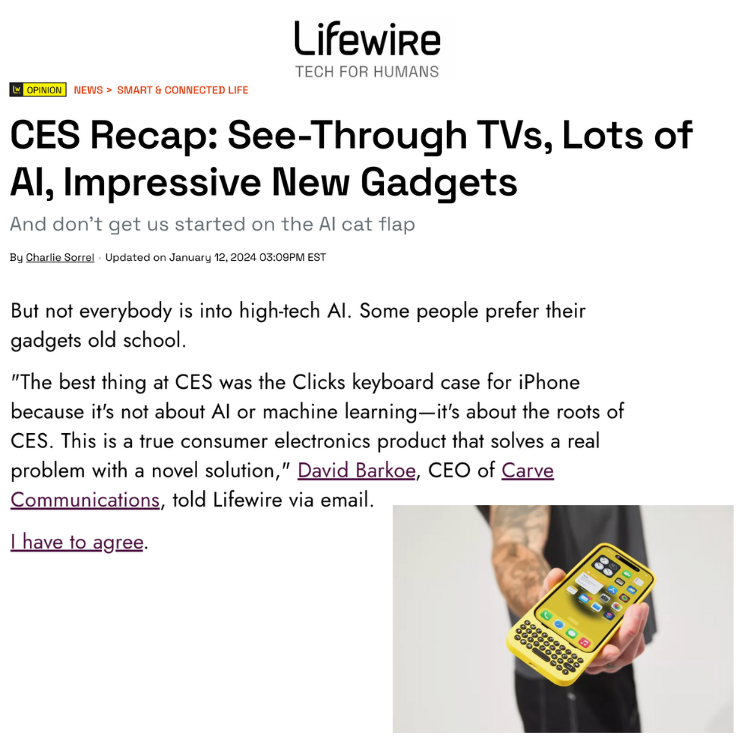Keeping Up PR Momentum Post-CES
Written by Rylie Miller
Refreshed January 28, 2025
Over 141,000 people attended CES 2025 this year. Six of them were Carvers representing five clients: Abacus, Golden Bear, Lockly, Ultra Pro, and Ohdoki.
We’ve been doing this for a combined 30+ years. From months of prepping and planning PR strategies, to actually attending and working the event itself, every year is a whirlwind experience. Every year, we also continue to refine what works.
One of the biggest questions we get is: How do we keep the momentum going? Once CES concludes and everyone heads home, what’s next?
We asked our experts for their best trade tricks on where to take the PR strategy post-CES.
Here’s what works.
Top 3 Tips for Your Post-Event Strategy
Follow-ups, follow-ups, follow-ups!
Events can get chaotic and names and faces get lost in the mix; taking the time to reach out afterward to start building media relationships will go a long way.
Say a reporter you met during CES wasn’t a good fit for your current pitching angles. Well, angles and clients change, and months down the line you may find yourself with a perfect pitch-reporter match. Make an effort to check in with them on a regular basis – not exclusively following CES. See what they are currently working on or what opportunities they have coming down the line. Switch your mindset from “pitching” to engaging with the media – trust us, the results will speak for themselves.
Ensure your follow-up stands out by going beyond the generic “Thank you for stopping by booth #X at CES!” message. Take the time to really personalize it. Craft an eye-catching subject line and curate your message with specifics.
If you or a colleague connected with them personally, mention that. If you talked about a shared interest or even complimented them on their sneakers, call that out! This will pull the memory of the interaction from the reporter’s brain and cement you as a legitimate contact versus noise. This is also a great way to show a reporter that you appreciate their time.
If you connected with a reporter who ended up doing work on the spot with you and you promised images, quotes, or data, make sure you stick to your word. This will keep your reputation and credibility strong. Sharing assets right away and reminding them why they asked, what it’s for, who you are, and where you’re from does just that.
Perhaps one of your connections was unable to make it to the event, let them know you missed them and send them an email sharing any relevant announcements. This shows the relationship is important since you’re keeping them in mind despite the chaos.
“CES is a land of possibilities, both good and bad. Flights can get delayed, reporter's appointments with other brands may run over or unforeseen circumstances may cut their CES time short. However, missed connections on the show floor can still turn into opportunities post-Vegas,” Carver Matt Burkey said. “Scheduling virtual meetings for those you couldn't touch base with during We hosted a post-CES LinkedIn Live where we dug into how to keep the momentum moving and kickstart your PR strategy for the next year, giving attendees the chance to ask our experts anything and everything about the show. the event, or even sending media-ready samples along after CES for additional coverage consideration can go a long way in building a meaningful relationship.”
Moving beyond the one-and-done mentality of live events can really help your brand secure opportunities in the future.
Share your experiences
Sharing your CES experiences builds authority for yourself and your brand. You can do this in several ways, including:
Highlight your CES-related coverage. This can be on your brand’s LinkedIn feed or website, on the featured section of your personal profile, in newsletters, or across other brand-owned and operated social channels. We hosted a post-CES LinkedIn Live where we dug into how to keep the momentum moving and kickstart your PR strategy for the next year, giving attendees the chance to ask our experts anything and everything about the show.
Create thought leadership content that gives your perspective on trending post-CES news. Think about your brand’s unique angle and what you can offer that’s valuable to your potential customers. This can be in the form of blogs, videos, webinars, or even something more creative. We’ve done a combination of all of the above! Match your goals to the format and your distribution strategy.
Use LinkedIn or your brand’s newsletter as a tool to recap your learnings and takeaways from the event with your network. Stay close to what others are discussing and add commentary to those posts.
Add your hot take to a reporter’s query. Our CEO, David Barkoe, was blown away by the Clicks keyboard case for iPhones. His POV stood out because it went against the grain of “AI everything” and highlighted the value the product gives to users by solving a minuscule problem we encounter every day – struggling to type on our touchscreens. He was quoted in a CES Recap in Lifewire, where his commentary will live on.
PRO TIP: Instead of just dropping a link to your coverage on LinkedIn or leaving a basic “Check this out!” CTA, spice it up by creating a narrative around the nature of the coverage itself. Are you solving a major problem? Were you featured alongside other prominent brands? What story can you tell? This will help your content stand out, versus getting lost in everyone’s feed.
Take a step back and evaluate
Make time to gather with your team for an event post-mortem debrief. Reflect on all the good, the bad, and the areas for improvement.
Take time to ask questions like:
Did we meet or exceed our KPIs?
What were the top trends coming out of the show and how can we work our story into them?
How does the media response impact our current PR strategies?
How did your team perform during interviews? Do spokespeople need more detailed media briefs?
Which event or media engagement did you find the most successful AND why?
Were the right people in attendance?
What are we going to do next year to rise above the noise?
One thing we always consider is how soon we should start planning our next CES (or any other event) strategy and the answer is usually: sooner than ever.
Don’t wait until November to re-ignite relationships with friendlies who may be there. Stay in touch sooner rather than later. Plan on being earlier than ever on pretty much everything. Make sure you lock in your schedule (media interviews, dinners, and more!) and have a backup plan if anything changes or falls through at the last minute.
Schedule the debrief while everyone’s minds are still fresh. When takeaways are still top of mind, you can put them in writing and get a start on next year’s post-event strategy.
With events, there’s always the pre-event strategy to consider. But don’t let your post-event strategy suffer. Follow up quickly and specifically, tell the world what you conquered while there, and prioritize your team’s post-event strategy debrief. Above all – make sure you wear comfortable shoes at next year’s event! (See more in our pre-CES checklist here.)






